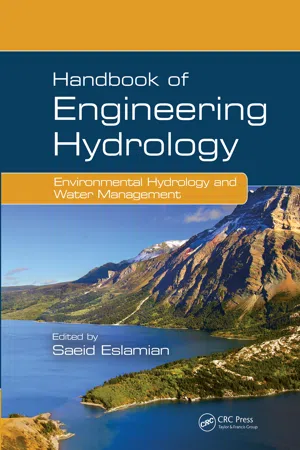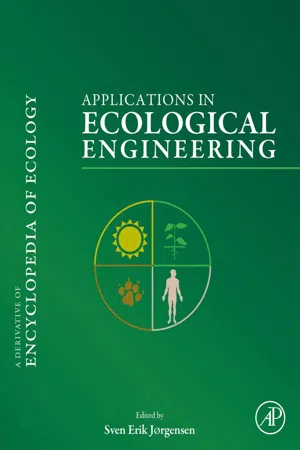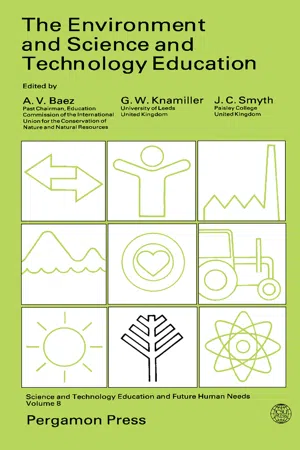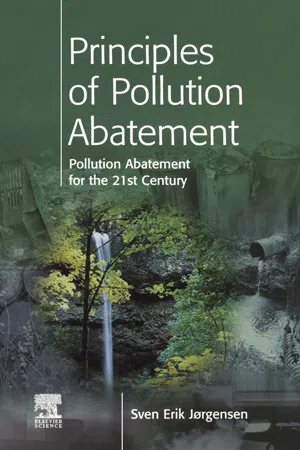Technology & Engineering
Environmental Engineering
Environmental engineering involves the application of scientific and engineering principles to protect and improve the environment. It focuses on addressing issues such as air and water pollution, waste management, and sustainable development. Environmental engineers work to design and implement solutions that minimize the impact of human activities on the natural world.
Written by Perlego with AI-assistance
Related key terms
1 of 5
10 Key excerpts on "Environmental Engineering"
- eBook - ePub
- Stefan Fränzle, Bernd Markert, Simone Wünschmann(Authors)
- 2012(Publication Date)
- Wiley-VCH(Publisher)
Environmental Engineering :Environmental Engineering is the technology concerned with the reduction of pollution, contamination and deterioration of the surroundings in which humans live, including environment and management of natural resources. This integrated management – beyond purification (waste or flue gas treatments) – includes reuse, recycling and recovery measures.Accordingly, Environmental Engineering occurs at the interface of technical and environmental systems, and it requires a certain size of mass turnovers, even though the single devices may be fairly small if distributed among a multitude of individual pollution sources, like with catalytic exhaust gas converters.Understanding chemical processes in the environment of course takes a sound knowledge of the array of compounds, ions and elements which are there, and of their distribution among the environmental compartments, which in turn controls their exposure to secondary influences (e.g., UV irradiation, activation by chemisorption to, e.g., clay minerals). To obtain the corresponding information, lots of analytical data are required, that is, environmental analysis is warranted, while the secondary effects can only be described and evaluated concerning their implications for a realistic environmental setting by simulation experiments (Figure 1.1 ). Taken alone, it is rather pointless to determine the environmental half-life1) - eBook - PDF
Handbook of Engineering Hydrology
Environmental Hydrology and Water Management
- Saeid Eslamian(Author)
- 2014(Publication Date)
- CRC Press(Publisher)
78 Layout of Sanitary Engineering Works 4.6 Waste Water Systems .......................................................................... 79 Waste Water Treatment 4.7 Summary and Conclusions ............................................................... 81 Acknowledgment ............................................................................................ 81 References ........................................................................................................ 81 Bosun Banjoko Obafemi Awolowo University 66 Handbook of Engineering Hydrology: Environmental Hydrology and Water Management 4.1 Introduction Environmental Engineering is the application of science and engineering principles and techniques to improve the natural environment including air, water, and land resources. The scope extends to waste water management, remediation of polluted sites, air pollution control, water and material recycling, waste disposal, environmental impact assessment, radiation protection, industrial hygiene, and environment sustainability. All environmental-friendly technologies can be said to fall within the purview of environmental engineers. Environmental engineers are responsible for the design of municipal water supply and industrial waste water systems. For the purpose of this chapter, however, the focus will be more on hydrology, sani-tation, water resources management, and water treatment plant design. In Environmental Engineering, there are cross-activities between the disciplines of environmental science, ecology, biology, chemistry, civil engineering, chemical engineering, and agricultural engineering. The knowledge of these disci-plines is therefore essential to Environmental Engineering specialty. From historical perspectives, the practice of Environmental Engineering could be traced to the Harappan Civilization of the Indus Valley, in Punjab, Pakistan, dated 3000–1300 BC where archeological excavations revealed the presence of sewers [35]. - eBook - PDF
- Sven Erik Jørgensen(Author)
- 2009(Publication Date)
- Academic Press(Publisher)
All rights reserved. What Is Ecological Engineering? Classification of Ecotechnology Further Reading What Is Ecological Engineering? The most used definition of ecological engineering employs the following formulation: ecological engineer-ing is defined as the design of sustainable natural and artificial ecosystems that integrate human society with its natural environment for the benefit of both. It requires, on the one hand, that we understand nature and ensure a sustainable development of natural resources and ecosys-tems and, on the other hand, that we make use (but not abuse) of natural resources to the benefit of the human society. Thus, our inevitable interactions with nature must be made under the comprehensive consideration of the sustainability and balance of nature. H. T. Odum was among the first to define ecological engineering as the ‘‘environmental manipulation by man using small amounts of supplementary energy to control systems in which the main energy drives are coming from natural sources.’’ Odum further developed the concept of ecological engineering as follows: ecolo-gical engineering, the engineering of new ecosystems designs, is a field that uses systems that are mainly self-organizing. Straskraba has defined ecological engineering (or eco-technology, as he called it) more broadly, as being the use of technological means for ecosystem management, based on a deep ecological understanding, in order to minimize the costs of measures and their harm to the environment. For the purposes of this report, ecological engineering and ecotechnology may be considered synonymous. Ecological engineering is engineering, in the sense that it involves the design of man-made or natural ecosystems or parts of ecosystems. Like all engineering disciplines, it is based on basic science, in this case ecology and systems ecology. The biological species are the components applied in ecological engineering. - eBook - ePub
Environmental Biotechnology
A Biosystems Approach
- Daniel A. Vallero(Author)
- 2015(Publication Date)
- Academic Press(Publisher)
[10] . Environmental Engineering seldom, if ever, can rely exclusively on a single scientific solution but is always a choice among many possible solutions dictated by the particular environmental conditions. The design of environmentally sound and socially acceptable biotechnologies calls for the application of all of the biological and physical sciences.Figure 13.11 Value-added chain from data to knowledge and, with experience, professional wisdom. Source: Adapted from Vallero DA. Environmental contaminants: assessment and control. Burlington, MA: Elsevier Academic Press; 2004.Figure 13.12 Functional analysis diagram for waste collection, distribution, treatment, disposal, end-of-life, operation, maintenance, and planning for military deployments.Source: Ref. [25] .Environmental Engineering
Throughout the first half of the twentieth century, when the field was predominantly considered “sanitary engineering,” structural considerations were paramount. Yet, even then, operational conditions had to include chemistry and biology as well as fluid mechanics and other physical considerations. This amalgam of science grew more complex as those who designed pollution control systems earned the designation of “environmental engineers.”All engineers apply scientific principles. Every engineering discipline applies chemical principles to some extent; certainly the “life science engineers” and biomedical and environmental engineers are steeped in chemistry. Most importantly, biomedical and environmental engineers must also account for biology. In the case of Environmental Engineering, the concern for biology ranges across all kingdoms, phyla, species, subspecies, and stains. Engineers use biological principles and concepts to solve problems, for example bacteria and fungi adapted to treat wastes, algae and macrophytes to generate biofuels, macrophytic flora to extract and degrade contaminants (i.e., phytoremediation) and to restore wetlands, benthic organisms to help clean contaminated sediments, including benthic and soil fauna to degrade pollutants, and organisms from all kingdoms as indicators of environmental conditions. - eBook - PDF
Integrated Environmental Management
A Transdisciplinary Approach
- Sven Erik Jörgensen, Joao Carlos Marques, Søren Nors Nielsen(Authors)
- 2015(Publication Date)
- CRC Press(Publisher)
271 12 Application of Ecotechnology and Ecological Engineering in Environmental Management 12.1 What Is Ecotechnology and Ecological Engineering? H.T. Odum (1982, 1983) was among the first to define ecological engineering as the “environmental manipulation by man using small amounts of sup-plementary energy to control systems in which the main energy drives are coming from natural sources.” Odum (1983) further developed the concept of ecological engineering as follows: ecological engineering, the engineer-ing of new ecosystems designs, is a field that uses systems that are mainly self-organizing. Straskraba (1985) has defined ecological engineering, or as he calls it ecotechnology, more broadly, as the use of technological means for ecosystem management, based on a deep ecological understanding, to mini-mize the costs of measures and their harm to the environment. Ecological engineering and ecotechnology may be considered synonymous. Mitsch and Jørgensen (1989) give a slightly different definition which, however, covers the same basic concept as the definition given by Straskraba and also encompasses the definition given by H.T. Odum. They define eco-logical engineering and ecotechnology as the design of human society with its natural environment for the benefit of both. It is engineering in the sense that it involves the design of man-made or natural ecosystems or parts of ecosystems. Like all engineering disciplines it is based on basic science, in this case ecology and systems ecology. The biological species are the com-ponents applied in ecological engineering. Ecological engineering therefore represents a clear application of ecosystem theory. Ecotechnic is another often applied word, but it encompasses in addition to ecotechnology or ecological engineering also the development of technology applied in society, based upon ecological principles, for instance all types of cleaner technology, particularly if they are applied to solve an environmen-tal problem. - eBook - PDF
The Environment and Science and Technology Education
Science and Technology Education and Future Human Needs
- A. V. Baez, G. W. Knamiller, J. C. Smyth(Authors)
- 2013(Publication Date)
- Pergamon(Publisher)
Everyone is responsible for the protection of our precious environment, now and in the future: society, the economy, and the individual. However, universities and other institutions of learning bear a special responsibility, since they are educating precisely those people who will share in the shaping of our environment tomorrow - the technicians and engineers. Thus, environmental protection constitutes an increasingly vital task of social policy and engineering education, whose content and objectives must be orientated towards the desired quality of life. This page intentionally left blank Environmental Education for Engineering and Technology - An Analysis of Experience in India R. D. DESHPANDE Environmental problems vary widely in nature, magnitude and complexity in the countries of the Asia-Pacific Region. It is increasingly being realized that, if truly harmonious relations have to be developed between people and their environment, certain economic and technological orientations which would have an adverse effect on the quality of the environment and the conservation of its productive potential, must be reviewed. This has led to the adoption of legislation concerning the environment, setting up apex decision-making bodies in environment at the national level and incorpor-ation of an environmental dimension into the education process. While planning environmental education for engineers and technologists two fundamental ideas have to be borne in mind. The first is that environmental education is not to be regarded as a new discipline representing simply an addition to already existing subjects. It should comprise contributions from all disciplines concerned with knowledge and understanding of the environment and the solution of its problems and its management. - Sven Erik Jorgensen(Author)
- 2016(Publication Date)
- CRC Press(Publisher)
12Application of Ecotechnology/Ecological Engineering in Environmental Management
12.1 What Is Ecotechnology and Ecological Engineering?
H.T. Odum was among the first to define ecological engineering (Odum, 1962, 1983) as the “environmental manipulation by man using small amounts of supplementary energy to control systems in which the main energy drives are coming from natural sources.” Odum further developed the concept (Odum, 1983) of ecological engineering as follows: ecological engineering, the engineering of new ecosystems designs, is a field that uses systems that are mainly self-organizing. Straskraba (1985) has defined ecological engineering, or as he calls it ecotechnology, more broadly, as the use of technological means for ecosystem management, based on a deep ecological understanding, to minimize the costs of measures and their harm to the environment. Ecological engineering and ecotechnology may be considered synonymous.Mitsch and Jørgensen (1989) give a slightly different definition, which, however, covers the same basic concept as the definition given by Straskraba and also encompasses the definition given by H.T. Odum. They define ecological engineering and ecotechnology as the design of human society with its natural environment for the benefit of both. It is engineering in the sense that it involves the design of man-made or natural ecosystems or parts of ecosystems. Like all engineering disciplines, it is based on basic science, in this case ecology and system ecology. The biological species are the components applied in ecological engineering. Ecological engineering represents therefore a clear application of ecosystem theory.Ecotechnic is another often-applied word, but also it encompasses in addition to ecotechnology or ecological engineering the development of technology applied in society, based upon ecological principles, for instance, all types of cleaner technology, particularly if they are applied to solve an environmental problem. Even the use of composting, solar cells, and wind energy may be considered in some context as ecotechnique.- eBook - PDF
- S. Jørgensen(Author)
- 2000(Publication Date)
- Elsevier Science(Publisher)
8. Ecological Engineering 8.1 WHAT IS ECOLOGICAL ENGINEERING? H.T. Odum was among the first to define ecological engineering (Odum, 1962 and Odum et al., 1963) as the environmental manipulation by man using small amounts of supplementary energy to control systems in which the main energy drives are coming from natural sources. Odum further developed the concept (Odum, 1983) of ecological engineering as follows: ecological engineering, theengineering of new ecosystems designs, is a field that uses systems that are mainly self-organising. Straskraba (1984 and 1985) has defined ecological engineering, or as he calls it ecotechnology, more broadly, as the use of technological means for ecosystem management, based on a deep ecological understanding, to minimise the costs of measures and their harm to the environment. Ecological engineering and ecotechnology may be considered synonymous. Mitsch and Jorgensen (1989) gives a slightly different definition which, however, covers the same basic concept as the definition given by Straskraba and also encompasses the definition given by H.T. Odum. They define ecological engineering and ecotechnology as the design of human society with its natural environment for the benefit of both. It is engineering in the sense that it involves the design of man-made or natural ecosystems or parts of ecosystems. Like all engineering disciplines it is based on basic science, in this case ecology and system ecology. The biological species are the components applied in ecological engineering. Ecological engineering represents therefore a clear application of ecosystem theory. Ecotechnic is another often applied word, but it encompasses in addition to ecotechnology or ecological engineering also the development of technology applied in society, based upon ecological principles, for instance all types of cleaner technology, particularly if they are applied to solve an environmental problem. - Carl Etnier, Bjorn Guterstam(Authors)
- 2013(Publication Date)
- CRC Press(Publisher)
Chapter 2 THE FUNCTION OF ECOLOGICAL ENGINEERING IN ENVIRONMENTAL CONSERVATION WITH SOME CASE STUDIES FROM CHINA Yan Jingsong and Ma Shijun INTRODUCTION For several decades attempts have been made to prevent pollution and protect the environment. Some engineering techniques already applied with more or less success are: (1) Environmental Engineering, such as dilution (as used in West Lake, Hangzhou, China) and dredging (as in Qinhuai River, Nanjing, China), and (2) artificial mechanical-chemical regeneration systems (as in many sewage treatment plants, including settling tanks, scrubbers, and sand filters). These measures are often too expensive, if possible at all, and many may cause extensive disturbances of other ecosystems. Their application is limited by some conditions (particularly economic), and they may not be freely used everywhere, especially in developing countries and regions. Therefore, alternative approaches are to be sought which can produce economic benefits and, at the same time, offer ecological, environmental, and social advantages. One such approach is ecological engineering. DEFINITION OF ECOLOGICAL ENGINEERING Ecological engineering may be defined as a specially designed and operated system for production processes combined with the management of the natural environment, for the benefit of both. The holistic principles of harmony, regeneration, and recycling of nutrients in an ecosystem (or co-ecosystem) are applied through the adoption of system engineering technology. Environmentally sound traditional production practices, introduced techniques, and new developments are applied, along with environmental protection measures, to create a multi-stepped and multi layered use of nutrients, which should result in increased production and greater economy. The potential for useful products, including the waste from every produc tion step, would be brought into full play and maximized, while environmental degradation is minimized.- eBook - ePub
- Toolseeram Ramjeawon(Author)
- 2020(Publication Date)
- CRC Press(Publisher)
1Sustainable Development and Role of Engineers
You can resist an invading army, you cannot resist an idea whose time has come. (Victor Hugo)1.1 IntroductionThere are many different definitions of engineering, but one which suits the purpose of this book is as follows:The profession in which knowledge of the mathematical and natural sciences is applied with judgement to develop ways to utilize, economically, the materials and forces of nature for the benefit of mankind(Accreditation Board for Engineering and Technology). The definition makes reference to the use of “judgement,” which is applied for the “benefit of mankind.” It also includes a context which is one of constraints, including those imposed by the law, finance, ethics, and people. The professional conditions of engineering and the societal problems engineering should solve changed in the course of time. Today, the context is one of resource scarcity, poverty for a significant fraction of the world’s population who cannot meet their basic needs, and our exceedance of the capacity of our planet to accommodate our emissions. This new context of recognizing the need to live within ecological constraints and to ensure more fairness in access to limited resources lies at the heart of the concept of sustainable development and which is now influencing engineering practice. Engineers tend to struggle with the concept that looks abstract, as there are no equations to optimize or no widely agreed upon standards to which they can adhere to. This chapter has the objective of making the concept clear and show its importance in sustainable engineering practice.1.2 Why and What Is Sustainable Development?Development is some set of desirable goals or objectives for society. It includes the basic aim of securing a rising level of income per capita or economic growth (traditionally regarded as the “standard of living”). But it is much more than just rising incomes and there is emphasis also on the “quality of life,” which includes health, educational standards, and environmental quality.
Index pages curate the most relevant extracts from our library of academic textbooks. They’ve been created using an in-house natural language model (NLM), each adding context and meaning to key research topics.









